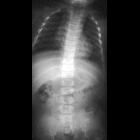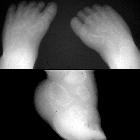Diastrophische Dysplasie







Diastrophic dysplasia (DTD) is a type of short limb skeletal dysplasia (micromelic dwarfism). Adult patients have a stature between 100 and 140 cm.
Epidemiology
There may be a relatively increased prevalence in Finland .
Clinical features
Typically there is limb shortening, hitchhiker thumbs, spinal deformity, and large joint contractures with associated deformities and premature degenerative disease. Other classic findings include ulnar deviation of the fingers, a large sandal gap (space between first and second pedal digits), and clubfoot. IQ is usually normal .
Pathology
Larger than normal collagen fibrils have been extracted from the cartilage matrix in these patients.
Genetics
It carries an autosomal recessive inheritance and thought to be due to mutations in the diastrophic dysplasia sulfate transporter (SLC26A2) gene located at chromosome 5q32-q33.1, resulting in under-sulfated proteoglycans in the cartilage matrix.
Associations
- micrognathia
- cleft lip +/- palate
- congenital cardiac anomalies: occasionally present
Radiographic features
Characterized by a micromelic dwarfism with hand deformities (abducted or hitchhiker thumb), multiple flexion contractures, and a scoliosis.
The bones are characterized by crescent-shaped flattened epiphyses, a short, broad femoral neck, and shortening and metaphyseal widening of the tubular bones. There is irregular deformity and shortening of the metacarpal bones, metatarsal bones, and phalanges. Abduction of the great toes and clubfeet may also be observed.
Treatment and prognosis
Life expectancy and mental function are usually normal. In view of its autosomal recessive inheritance, there is a 25% change of recurrence. Orthopedic input and intervention is often required for correction or stabilization of skeletal deformities.
History and etymology
The term diastrophic implies twisting and describes the twisted habitus in diastrophic dysplasia.
See also
Siehe auch:
- Herzfehler
- Klumpfuß
- Mikrognathie
- Skelettdysplasie
- Lippen-Kiefer-Gaumen-Spalte
- short limb skeletal dysplasias
- Atelosteogenesis
- Pseudodiastrophische Dysplasie
und weiter:

 Assoziationen und Differentialdiagnosen zu Diastrophische Dysplasie:
Assoziationen und Differentialdiagnosen zu Diastrophische Dysplasie:




